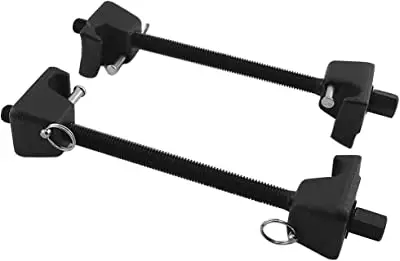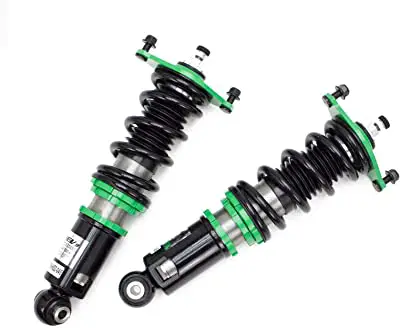The main differences between MacPherson struts and coilovers are that coilovers provide a much more adjustable ride height and damping stiffness than MacPherson struts. Coilovers are also significantly more expensive than MacPherson struts.
In the world of automotive suspension components, the jargon used can be overly difficult. Ironically, the rationale for simplifying suspension part names is to make everything simpler, not the other way around.
For instance, MacPherson Strut vs. Coilover has become a matter of more complicated debate in recent ties online. As we have seen so far, our experts have come up with them clarified to you. Here we’re going to compare these suspension systems in detail.
MacPherson Strut Vs Coilover In a Table

What Is A MacPherson Strut?

A MacPherson Strut is a suspension system that merges multiple trailhead roles while acting as a suspension utilizing its shock absorbers and trembling drops. Early designs required a separate part or parts of presidential campaigns automated.
The MacPherson Strut integrates essential nodes into the section of a suspension. This makes it a more efficient choice than two other rudimentary suspension systems, both of which have to be integrated with some other system.
What Are Coilovers?

Coilovers are a preferred form of contemporary auto suspension support, and superseding the product has to do with how the coilovers work. Technically, a coilover is a suspension component that helps prevent the proverbial slap-dash car from overextending itself.
Coilovers work by functioning on the same general principle, but the top difference is that they are paired with a coil pipe instead of attached to a strut. The coil pipe rests on an adjustable pedestal that allows you to adjust the ride height.
They also provide a smoother ride, giving you a decreased likelihood of scraping the front or rear of your car as you drive. Additionally, coils can also help you lessen body roll as your motor vehicle rolls around a corner.
MacPherson Strut vs. Coilover – Design and Construction
Do you have no experience regarding the construction and design of MacPherson struts and Coilovers? You could be fooled into believing that you are nothing in the automotive world. In reality, it isn’t as likely as a modern competition suspension like coilovers. Based on our information and experience, just the latter is the sheer amount of information for you.
MacPherson Strut
The MacPherson strut suspension design is used by almost all major automakers, offering simple, independent suspension for front wheels. This is “deconstructed” by a basic triangular frame, consisting of a control arm and radius rod, which combine to form the triangular shape corresponding to the vehicle.
As a rule of thumb, this triangle is at the bottom of the suspension rather than the top, though it can be implemented in places at all heights. The control arm connects to the wheel spider through the hub, and this connection typically releases the lower portion of the wheel spider.
In MacPherson Struts, the control arm is the chunkier and stronger structure of the two, which is connected directly to the lower part of the wheel carrier. Today, the functions of these two parts are more streamlined into one, larger control arm with a stabilizer bar that links the suspension unit and the chassis.
The spring and damper device is mounted vertically, whereas it’s chambered within a hollow cylinder near the center of the axis. Inside it is the piston bandage, which latches near the bottom of the cylinder. Vertically the spring channel is fixed with a brace around the spring, and the damper arm is carried throughout the coiled spring tube to its top, where you’ll find the clamp securing the spring shaft.
As car designers began constructing ever-more unibody chassis, also called monocoques, this design found its niche. Monocoque chassis or unibody design gives complete support and control, particularly in areas that are essential to smoothness such as the MacPherson strut mounts.
Coilovers
Coilovers, though used for a similar function, vary somewhat from one another. At present, coilovers come in three kinds of aftermarket configurations: OEM-style spring-over-shock assemblies, full-bodied coils, and slip-fit coilovers. Each of these comes in three different layouts.
A standard Coilover focuses on a wide variety, and rear upper and lower shafts are generally fixed at just one length. Enthusiastic models provide adjustable casings, though predictable heights are a choice you don’t see for yourself.
Slip-fit coilovers include a hollow, threaded (usually aluminum) tube with a hollow adapter that slips over, sits on, and compresses or decompresses a shock’s spring height by employing a series of jam nuts. The addition of coilovers to a vehicle’s shock settings may enjoy little discernible effect on vehicle performance, but they can enhance suspension firmness and chassis dynamics.
You are picturing coilovers as a full-body unit since you were reading about paragraph one. Coilovers, which replace a factory spring and shock assembly, have no threaded shock and have a jam nut for a method by which the ride height can be adjusted. Like slip-fit coilovers, ride height can be adjusted through adjustable compression and decompression.
Additionally, coilovers with a higher spring rate feature a threaded lower casing and lower mount, which can be adjusted up or down, effectively shortening the vehicle’s ride height without altering the compression of the suspension’s spring.
MacPherson Strut vs. Coilover – Working Mechanism
You might have seen a massive difference in terms of the design and construction of these two suspension systems. Now here is another distinct factor, which is their working mechanism. Yes, it’s probably the second most influencing factor that differentiates them. Let’s see how a MacPherson strut and Coilover works.
- Working Mechanism of MacPherson Strut
In a MacPherson strut, the unique components are the steering knuckle and hub carrier. However, these are interchangeable depending on the design and purpose.
These components are what most people think of when they are exposed to the use of the term strut. When they say that struts need to be replaced, it is often they mean the shock absorbers. The most common struts operate on pressurized gas.
The cabling connecting the knuckle of the assembly to a track control arm or lower control arm determines the wheel assembly’s longitudinal and lateral orientation, and the lower mounting point connects to a knuckle assembly via the tire wheel. On top of that, the upper mounting point of the tire wheel is attached to a knuckle assembly in a manner that contains a coil spring and a shock absorber.
Wherein the MacPherson strut allows you to adjust the camber and caster angles, as well as the shock absorption rate, you can use strut applies. Coil springs also help in absorbing the bumps on the road. Without the struts, the springs provide a more bumpy ride.
The principle behind MacPherson strut suspensions is that the axis of that strut itself also serves as the steering pivot — the lower pivot will be the mounting point between the knuckle and track or control arm. This upper pivot point will be attached to the rod’s end, which will be attached to the steering gear.
- Working Mechanism of Coilovers
Coilovers function similarly to coil springs and shock absorbers, using coils and an air-oxide-filled bladder to control outside the passenger compartment. Shock absorbers absorb vibration as you traverse bumpy road conditions, and as the road starts to level out automatically, they return to their original expansion.
Coil springs are made of similar construction, but they compress much more easily and offer little in the way of ride convenience, though they are necessary to keep your automobile from bottoming out. The Coilover is just the name for these shock absorbers with the coil wrapped around them. When you hit bumps in the vehicle, the coil compresses and the act of compression increases the test.
As an added convenience to those shopping for their car to be as low as possible, Coilover dampers that can be lowered are easier to compress. As you decrease the coilover damper, you compress the mainspring more. More compression on the primary coil weakens the coilover damper, causing a greater force to act on it at the top end.
Pros and Cons of MacPherson Strut
Everything in this world has both positive and negative sides, so the MacPherson strut is not outside the rule. Let’s see what are the pros and cons of MacPherson struts.
Pros:
- MacPherson struts are convenient, compact, and require very little space in their center, which makes them perfect for vehicles that not only have the engine located transversely in the front, but also that make use of the front wheels.
- It is lower cost and less structurally demanding than the multi-link structure. The propeller is nearly vertical and is not affected by the creation of small vehicles.
- The dynamics provided by MacPherson for simple and fast vehicles are particularly great. Thanks to the satisfactory long suspension travel, MacPherson’s parallel wheel guide functionality is fast.
- Floating over a high point is also good for larger vehicles since it is more stable and maneuverable. During braking, the MacPherson strut maintains stability.
Cons:
- One of the disadvantages of the MacPherson strut is that it is not suitable for powerful front-wheel drive vehicles. First, regardless of the manufacturer, it is not possible to mount large tires with large offset wheel rims or spacers without increasing the unsprung weight.
- The angle of inclination of the wheels, compared with the ground, slightly changes when turning the entire column. Likewise, this space is filled with friction, making it difficult for the damper piston rod to move.
Pros and Cons of Coilovers
Yes, no matter how good coilovers are, they also have some drawbacks. Let’s present again the pros and cons, but this time we have coilovers.
Pros:
- Coilovers can be a great solution for both long- and short-term needs. Not only are Coilovers able to adjust the height for your travels, but they also offer significant peace of mind when on the ground.
- The height of any vehicle is lowered using a coilover. This helps in the handling of sharp turning and cornering.
- Coilovers set up to meet your requirements instead of ignoring cheap versions will best satisfy your requirements. Heterogeneous shocks can similarly ensure that your car maneuvers efficiently.
- Crazy off-road enthusiasts can benefit from coilovers. They lessen the danger of a car collision due to an obstruction or curb, make security for the driver and this car’s fiberglass posterior more competent, and have turned into a popular suspension choice for many significant enthusiasts.
Cons:
- Car enthusiasts endorse the adjustable nature of improved coilovers, but detractors say coilovers stiffen a car up and make it uncomfortable to ride.
- Too frequently, coilovers are the main reason for road failure, especially for lower-end or less costly bailout grills. If you prioritize road safety, you should fully research top-notch models with favorable customer and endorsement feedback.
Final Words
At the end of the MacPherson Strut vs. Coilover battle, it’s quite evident that both of these suspension systems have their specific fan base and are efficient in their jobs. However, if you need something cost-effective, MacPherson struts should be your choice. On the other hand, if you need more versatility and something premium, Coilover will be the best bet.
More Differences: